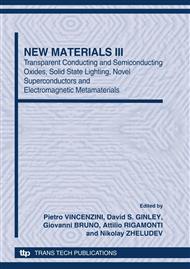p.74
p.79
p.91
p.97
p.103
p.108
p.118
p.124
p.130
Synthesis, Optical and Electrical Properties of Oligo(phenylenevinylene)s Substituted with Electron-Accepting Sulfonyl Groups
Abstract:
Oligo(phenylenevinylene)s (OPV) composed of five rings and electron donating or withdrawing sulfonyl substituents on the central and lateral rings have been investigated. Two strategies were used for the syntheses of the C2-symmetrical OPVs both include PO-activated olefinations as central steps. Six flexible side chains guarantee good solubility in toluene or dichloromethane. In solution and in films stabilised by polystyrene (60%), the chromophores are strongly fluorescent, with emissions in the violet-blue domain from solutions and in the green to orange region from solid films. The redox potentials, determined by cyclic voltammetry, and the optical properties are strongly depending on the position of the acceptor groups.
Info:
Periodical:
Pages:
103-107
Citation:
Online since:
October 2010
Authors:
Price:
Сopyright:
© 2010 Trans Tech Publications Ltd. All Rights Reserved
Share:
Citation:


